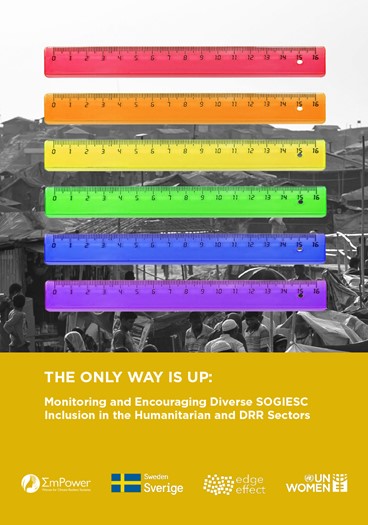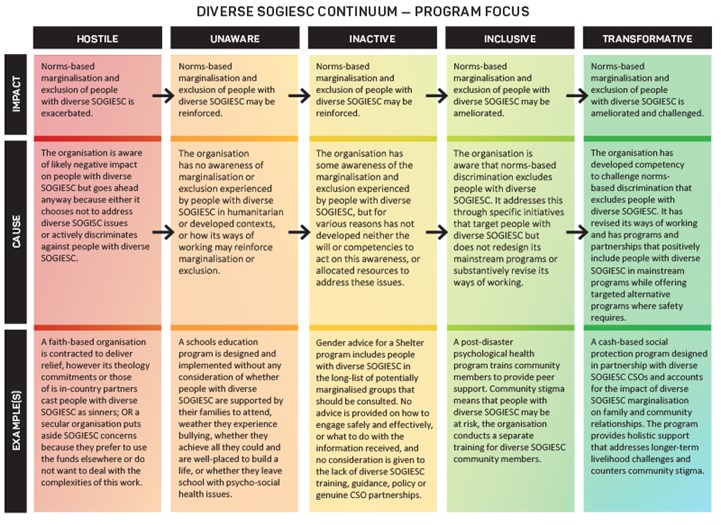Once emergency services organisations decide that LGBTIQ+ inclusion is important, what resources exist to support changes in organisational culture and program planning? Edge Effect’s, The Only Way Is Up, report and evaluation tool was designed for international humanitarian responses but could be easily used by domestic emergency organisations.
Category 5 Tropical Cyclone Harold reached Vanuatu on 5 April 2020. Almost 160,000 people were affected, primarily on Vanuatu’s northern islands including Espiritu Santo, Malo and Pentecost. The damage from wind and flooding was severe and multisectoral, affecting communications and destroying approximately 21,000 homes along with schools and health facilities as well as devastating agriculture and fishing fleets. One person experienced the immediate aftermath in this way:
I made sure that parents, niece, her mother and brother hopped in the transports to the evacuation centre. My mother begged me to go but I refuse to go. That fear from facing people and their comments is not something that I am ready to face.1
As recounted in The Only Way Is Up, dilemmas such as this are too common for people with diverse sexual orientations, gender identities and expressions and sex characteristics (SOGIESC, aka LGBTIQ+ people). Research has demonstrated that LGBTIQ+ people in Australia face their own challenges in surviving and recovering from disasters.2 For that reason, work in the regional sphere could have significant benefits for domestic emergency management organisations.
The Only Way Is Up draws on 5 years of work exploring LGBTIQ+ inclusion in rapid-onset disaster and conflict displacement across Asia and the Pacific. This includes Down By The River3 (research into experiences of LGBTIQ+ people after Tropical Cyclone Winston in Fiji in 2016) and Pride in the Humanitarian System4 (a 2018 regional gathering of SOGIESC civil society organisations and humanitarian response organisations).

The Only Way Is Up report and evaluation tool is published by Edge Effect.
Image: Edge Effect
Working through national civil society organisations, The Only Way Is Up includes experiences of people with diverse SOGIESC living in the Rohingya refugee camps in Bangladesh’s Cox’s Bazar. These people have been displaced by conflict or earthquakes on the Philippines island of Mindanao and lived through Tropical Cyclone Harold. These interviews reinforced that discrimination, violence and exclusion experienced prior to crises shapes experiences during relief and recovery phases including harassment from other survivors, being blamed for causing disasters and self-exclusion from relief centres and services to avoid unsafe situations. A parallel study of humanitarian sector assessments, program designs and funding in the same crises revealed a troubling lack of recognition of these issues.
How does change happen – or not happen?
A growing number of reports over the last decade highlight similar problems. The Only Way Is Up goes beyond re-stating the problem to analyse why the international humanitarian and disaster risk reduction systems seem slow to recognise the rights, needs and strengths of people with diverse SOGIESC. The international human rights principle that ‘all human beings are born free and equal in dignity and rights’5, the humanitarian system principle that ‘human suffering must be addressed wherever it is found’6, the Sendai Framework call for an ‘all-of-society’7 approach and the Sustainable Development Goals promise that 'no one will be left behind' all provide plenty of authority to do more. But even when the United Nations and other international organisations make a commitment to diverse SOGIESC inclusion, it often doesn’t go much further than adding the acronym ‘LGBTIQ+’ to a long list of potentially marginalised groups.
The inertia in addressing inclusion issues also occurs in Australia. Edge Effect joined a session panel at the 2021 Emergency Services Foundation International Women’s Day event, Let’s Choose to Challenge. At the session, an audience member (speaking with evident frustration) pointed out that ‘we have many reports that have surfaced experiences of discrimination, so what is the reason that organisations are not actually changing?’ (paraphrased).
The apparent resistance to change in the international humanitarian sector has led organisations such as Active Learning Network for Accountability and Performance and the CHS Alliance to analyse the sector as a complex and adaptive system. Such systems have many actors that influence and interact in ways that are not always predictable. Actors within the system (organisations, groups or individuals) tend to have established ways of working, which may be influenced by funding, competition, ideas, constraints and other factors. The ‘messiness’ of such systems means that top-down policy pronouncements and isolated interventions such as research reports or training workshops are fairly easily absorbed by the system, which then carries on pretty much as it did before.
Research for The Only Way Is Up included interviews with participants from Pride in the Humanitarian System. Participants were asked what factors helped or hindered their attempts to implement LGBTIQ+-inclusive ideas when they returned to their organisation. The hindering factors were clearly dominant with issues including lack of resources for dedicated projects, lack of LGBTIQ+ program skills among humanitarian and emergency services organisations and other priorities that always seemed to be more important.
Is change possible? Yes.
That picture seems a little bleak. Except that we know, despite all the odds, that change can happen.
In 1978, protestors at the first Sydney Gay and Lesbian Mardi Gras were arrested and their personal details were splashed across homophobic news reporting of the event. Forty years later, those people, now known as the ‘78ers’, rode in a double-decker bus that cruised up Oxford Street to the cheers of a roadside and broadcast audience in the hundreds of thousands. Change does happen, though it is often easier to see how it happens in retrospect.
Complex and adaptive systems theory is sometimes said to be better at describing the problem than finding the solution. But it does offer hints. It may help to think more about incentive structures that hinder change and how they could be reconfigured. Change may come faster if we apply pressure to the system in more ways, or if the range of actors within the system becomes more diverse. So, as well as high-level announcements, research reports and workshops, more effort could go into diversity within the paid and volunteer workforces. Effective grievance procedures could also be established so that good people don’t leave organisations out of frustration. Inclusive public communications could be used to tell diverse stories and stronger partnerships could be formed with specialist LGBTIQ+ and other organisations.
Monitoring change
Alongside such initiatives, a complex and adaptive systems approach needs monitoring to discern what is or is not working and to change tactics accordingly. The evaluation tool within The Only Way Is Up provides a way to benchmark existing emergency response programs for SOGIESC inclusion and for exploring options for improvement.
The tool is currently designed for international humanitarian responses and assesses diverse SOGIESC inclusion across 4 areas: i) organisation and program background, ii) gender analysis and needs assessments, iii) inclusion, participation and leadership and iv) safety and protection for marginalised groups and 2 optional thematic areas of v) shelter/housing and vi) livelihoods support. These are assessed through a combination of organisational and program documentation, interviews with key staff and consultation with people with diverse SOGIESC who are or would be beneficiaries. The result of this overall process is a score on the Edge Effect Diverse SOGIESC Continuum, from 0 (hostile) to 100 (transformative).
The participation of people with diverse SOGIESC is an essential step. It is accomplished through partnership with an LGBTIQ+ civil society organisation to achieve 2 objectives. The first objective is to ensure that the engagement with people with diverse SOGIESC occurs safely and that a good range of people are involved. This is more likely to occur through partnership with an LGBTIQ+ civil society organisation or network that has deep reach into their community. The second objective is accountability, ensuring that the process is robust and that people with diverse SOGIESC are part of discussions after the scoring. These facilitated discussions explore what the score means and what kinds of steps could improve future scores.
Edge Effect provides training and organisational development support that helps organisations to improve inclusion and transformation. The tool was piloted with United Nations Women programs in the Cox’s Bazar refugee camps in partnership with Bandhu Social Welfare Society. While some adaptation would be required for evaluating Australian domestic emergency response programs, this is certainly possible. Ideally, organisations would undertake the assessment at regular intervals, for example every 2 years, to track change over time and to make changes.
The Rapid Assessment Tool facilitates assessment of diverse SOGIESC inclusion at the detailed levels of programs and projects implemented by humanitarian organisations.

The Rapid Assessment Tool assesses diverse SOGIESC inclusion at the levels of programs and projects.
Image: Edge Effect
Be part of the journey
Despite the many stories of exclusion of people with diverse SOGIESC and the often systemic nature of the problem, there are causes for optimism including:
- the existence of LGBTIQ+ civil society organisations that can work with the emergency management sector
- the deepening understanding of how and why people with diverse SOGIESC are excluded in crises
- steps that staff are taking within emergency management organisations to increase diverse SOGIESC inclusion.
Too often this is still the work of isolated individuals or small groups, passionate about diverse SOGIESC inclusion, but at risk of burn-out. The hope is that The Only Way Is Up report and evaluation tool encourages more organisations to accelerate their journeys towards inclusion for all.


